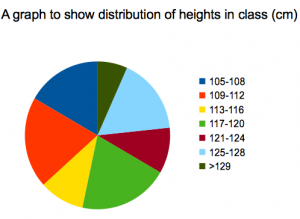Visualising data/activity: Difference between revisions
From OER in Education
No edit summary |
JanetBlair (talk | contribs) No edit summary |
||
| (5 intermediate revisions by 2 users not shown) | |||
| Line 19: | Line 19: | ||
| | | | | | ||
* Students measure various quantities (including but not limited to; arm length, height, hand span) and then analyse this data to look for patters of distribution amongst the class | * Students measure various quantities (including but not limited to; arm length, height, hand span) and then analyse this data to look for patters of distribution amongst the class | ||
* The spreadsheet allows graphs showing the data to be drawn instantaneously as the data is inputted helping student visualise the variation/distribution of the data within the class. | * The spreadsheet allows graphs showing the data to be drawn instantaneously as the data is inputted helping student visualise the variation/distribution of the data within the class | ||
[[File:SC0012_screenshot.png|thumb|none|alt=Graph of collected data.]] | |||
|- | |- | ||
| | Technology requirements and skills | | | Technology requirements and skills | ||
| | Computer with spreadsheet software and template file ([[ | | | Computer with spreadsheet software and template file ([[File:Class Data Set.ods]]). | ||
| Line 32: | Line 36: | ||
| | Equipment requirements | | | Equipment requirements | ||
| | | | | | ||
* Rulers or measuring tapes. For height and other length measurements if tapes/rulers are limited then a single measuring station (for example marked on wall) could be used for the whole class | * Rulers or measuring tapes. For height and other length measurements if tapes/rulers are limited then a single measuring station (for example marked on wall) could be used for the whole class | ||
* Paint/paper for handprints or drawing around hand (their own or each others) | |||
* Mini white boards could be used to engage class predictions of possible distributions (most common length, highest value, lowest value, etc) | * Mini white boards could be used to engage class predictions of possible distributions (most common length, highest value, lowest value, etc) | ||
| Line 39: | Line 45: | ||
|- | |- | ||
| | Possible extension or supplementary activities | | | Possible extension or supplementary activities | ||
| | * Data sets for other classes (or indeed the whole school) could be collected and students could see if the patterns/distributions seen in one class were | | | | ||
* Calculators could be used to work | * Data sets for other classes (or indeed the whole school) could be collected and students could see if the patterns/distributions seen in one class were similar/different to others | ||
* Calculators could be used to work out averages and other data analysis as an alternative, see moving stones activity for examples | |||
Some students may analyse the data further, calculating the mean, mode, median of the data set (see counting stones activity for more suggestions and instructions) | * Some students may analyse the data further, calculating the mean, mode, median of the data set (see counting stones activity for more suggestions and instructions) | ||
|- | |- | ||
| | Suggestions of what ‘successful’ student understanding or work might look like | | | Suggestions of what ‘successful’ student understanding or work might look like | ||
| | | | | | ||
Students will be familiar with the idea that certain human characteristics have a range (and distribution) distribution of values within a group | * Students will be confident collecting and handling data sets | ||
* Students will be familiar with the idea that certain human characteristics have a range (and distribution) distribution of values within a group | |||
|} | |} | ||
Latest revision as of 12:19, 19 June 2012
| Subject | Science |
| Activity Name | Variation of human characteristics |
| Learning Objectives |
|
| Outline of activity |
|
| Technology requirements and skills | Computer with spreadsheet software and template file (File:Class Data Set.ods).
|
| Equipment requirements |
|
| Possible extension or supplementary activities |
|
| Suggestions of what ‘successful’ student understanding or work might look like |
|

